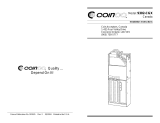
8514-223-003 REV B page 20
Plus Cycle Options:
The “Plus Cycle” options allow for the user to prompt the customer for varying vend
prices based on additional wash baths chosen. In general, the user can program the
additional wash baths in a similar manner to what was described in the “Cycles”
Options section.
It also allows the user to return the programmable values to the factory default setting.
No plus cycle options are active using the factory default. To reset all values in the Plus
Cycles option to factory default, press “Enter” when the “DEFAULT” prompt is shown.
Press “Enter” again when the “RESET” prompt is shown to confirm the action.
1. “Pre-Wash”- If the user programs a “Cycle Time” for “Pre-Wash” other than 0
(“No Cycle”), the feature becomes active. However, the customer will not be
prompted to pay an additional vend price for “Pre-Wash” unless the user
programs the Price to a value other than 0 (“Free”). With the “Pre-Wash”
feature active, an additional bath and, optionally, an additional spin, will occur
before the standard Wash bath described in the Cycles Options section.
With the “Pre-Wash” feature active and a “Price” value programmed, the
customer will be prompted to add additional coins if they wish to purchase the
“Pre-Wash” feature. This will occur after they have entered coins to meet the
Base Vend price. If the customer does not meet the vend price of the “Pre-
Wash” feature, the prompt will time out and the “Pre-Wash” bath will not occur.
2. “Extend Wash”- If the user programs an “Extend Time” for “Extend Wash” other
than 0, the feature becomes active. However, the customer will not be prompted
to pay an additional vend price for “Extend Wash” unless the user programs the
Price to a value other than 0 (“Free”).
With the “Extend Wash” feature active, the standard Wash bath described in the
Cycles section will be extended for the additional time selected. With the “Extend
Wash” feature active and a “Price” value programmed, the customer will be
prompted to add additional coins if they wish to purchase the “Extend Wash”
feature. This will occur after they have pressed the “Start” button to begin the
normal Wash cycle. If the customer does not meet the vend price of the “Extend
Wash” feature, the prompt will time out and the additional time will not be
added to the Wash bath.
3. “Extra Rinse”- If the user programs a “Cycle Time” for “Extra Rinse” other than 0
(“No Cycle”), the feature becomes active. However, the customer will not be
prompted to pay an additional vend price for “Extra Rinse” unless the user
programs the Price to a value other than 0 (“Free”).
With the “Extra Rinse” feature active, an additional bath and, optionally, an
additional spin, will occur after the standard “Final Rinse” bath described in the
Cycles Options section. With the “Extra Rinse” feature active and a Price value
programmed, the customer will be prompted to add additional coins if they wish
to purchase the “Extra Rinse” feature. This prompt will occur during the standard
























